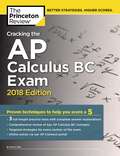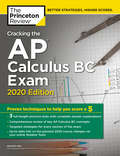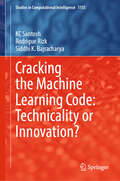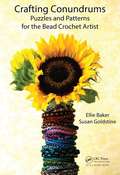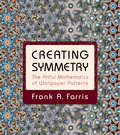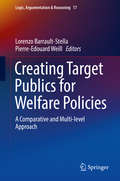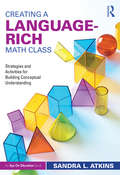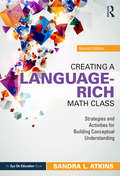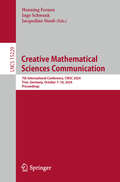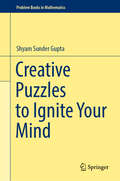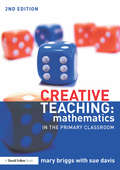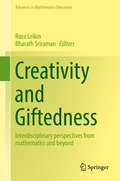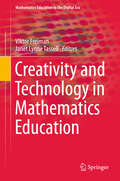- Table View
- List View
Cracking the AP Calculus BC Exam, 2018 Edition: Proven Techniques to Help You Score a 5
by Princeton ReviewEVERYTHING YOU NEED TO SCORE A PERFECT 5. Ace the AP Calculus BC Exam with this comprehensive study guide—including 3 full-length practice tests, thorough content reviews, access to our AP Connect online portal, and targeted strategies for every question type.This eBook edition has been optimized for on-screen learning with cross-linked questions, answers, and explanations. Written by the experts at The Princeton Review, Cracking the AP Calculus BC Exam arms you to take on the test with:Techniques That Actually Work.• Tried-and-true strategies to avoid traps and beat the test• Tips for pacing yourself and guessing logically• Essential tactics to help you work smarter, not harderEverything You Need to Know for a High Score.• Up-to-date information on the 2018 AP Calculus BC Exam• Comprehensive content review for all test topics• Engaging activities to help you critically assess your progress• Access to AP Connect, our online portal for late-breaking news, exam updates, and morePractice Your Way to Excellence.• 3 full-length practice tests with detailed answer explanations• Practice drills throughout each content review chapter• Step-by-step walk-throughs of key calculus formulas and sample questions
Cracking the AP Calculus BC Exam, 2019 Edition: Practice Tests & Proven Techniques to Help You Score a 5 (College Test Preparation)
by Princeton ReviewEVERYTHING YOU NEED TO SCORE A PERFECT 5. Ace the AP Calculus BC Exam with this comprehensive study guide—including 3 full-length practice tests, thorough content reviews, targeted strategies for every question type, and access to online extras.Techniques That Actually Work.• Tried-and-true strategies to avoid traps and beat the test• Tips for pacing yourself and guessing logically• Essential tactics to help you work smarter, not harderEverything You Need to Know for a High Score.• Comprehensive content review for all test topics• Up-to-date information on the 2019 AP Calculus BC Exam• Engaging activities to help you critically assess your progress• Access to online drills, study plans, a handy list of formulas, helpful pre-college information, and morePractice Your Way to Excellence.• 3 full-length practice tests with detailed answer explanations• Practice drills throughout each content review chapter• Step-by-step walk-throughs of key calculus formulas and sample questionsWritten by the experts at The Princeton Review, Cracking the AP Calculus BC Exam arms you to take on the test and achieve your highest possible score.
Cracking the AP Calculus BC Exam, 2020 Edition: Practice Tests & Proven Techniques to Help You Score a 5 (College Test Preparation)
by The Princeton ReviewEVERYTHING YOU NEED TO SCORE A PERFECT 5. Ace the AP Calculus BC Exam with this comprehensive study guide—including 3 full-length practice tests, thorough content reviews, targeted strategies for every question type, and access to online extras.Techniques That Actually Work.• Tried-and-true strategies to avoid traps and beat the test• Tips for pacing yourself and guessing logically• Essential tactics to help you work smarter, not harderEverything You Need to Know to Help Achieve a High Score.• Comprehensive content review for all test topics• Up-to-date information on the planned 2020 course changes via your online Student Tools• Engaging activities to help you critically assess your progress• Access to online drills, study plans, a handy list of formulas, helpful pre-college information, and morePractice Your Way to Excellence.• 3 full-length practice tests with detailed answer explanations• Practice drills throughout each content review chapter• Helpful reference guide of of key calculus formulas and comprehensive drills available online
Cracking the AP Statistics Exam, 2014 Edition
by Princeton ReviewTHE PRINCETON REVIEW GETS RESULTS. Get all the prep you need to ace the AP Statistics Exam with 2 full-length practice tests, thorough topic reviews, and proven techniques to help you score higher. This eBook edition has been optimized for digital viewing with cross-linked questions, answers, and explanations.Inside the Book: All the Practice & Strategies You Need * 2 full-length practice tests with detailed explanations * Expert subject reviews for all test topics* Practice drills at the end of each chapter* Strategies & techniques for every section of the exam* Comprehensive tutorial on how to use your calculator on the exam
Cracking the AP Statistics Exam, 2015 Edition
by Princeton ReviewEVERYTHING YOU NEED TO SCORE A PERFECT 5. Equip yourself to ace the AP Statistics Exam with The Princeton Review's comprehensive study guide--including thorough content reviews, targeted strategies for every question type, and 2 full-length practice tests with complete answer explanations. This eBook edition has been optimized for on-screen viewing with cross-linked questions, answers, and explanations.We don't have to tell you how tough AP Statistics--or how important a stellar score on the AP exam can be to your chances of getting into a top college of your choice. Written by Princeton Review experts who know their way around stats, Cracking the AP Statistics Exam will give you:Techniques That Actually Work.* Tried-and-true strategies to avoid traps and beat the test* Tips for pacing yourself and guessing logically* Essential tactics to help you work smarter, not harderEverything You Need to Know for a High Score.* Comprehensive content review for all test topics* Up-to-date information on the 2015 AP Statistics Exam* Engaging activities to help you critically assess your progressPractice Your Way to Perfection.* 2 full-length practice tests with detailed answer explanations* Practice drills at the end of every content review chapter* Step-by-step walk-throughs for how to set up box plots, dot plots, and other statistics graphs
Cracking the Machine Learning Code: Technicality or Innovation? (Studies in Computational Intelligence #1155)
by KC Santosh Rodrigue Rizk Siddhi K. BajracharyaEmploying off-the-shelf machine learning models is not an innovation. The journey through technicalities and innovation in the machine learning field is ongoing, and we hope this book serves as a compass, guiding the readers through the evolving landscape of artificial intelligence. It typically includes model selection, parameter tuning and optimization, use of pre-trained models and transfer learning, right use of limited data, model interpretability and explainability, feature engineering and autoML robustness and security, and computational cost – efficiency and scalability. Innovation in building machine learning models involves a continuous cycle of exploration, experimentation, and improvement, with a focus on pushing the boundaries of what is achievable while considering ethical implications and real-world applicability. The book is aimed at providing a clear guidance that one should not be limited to building pre-trained models to solve problems using the off-the-self basic building blocks. With primarily three different data types: numerical, textual, and image data, we offer practical applications such as predictive analysis for finance and housing, text mining from media/news, and abnormality screening for medical imaging informatics. To facilitate comprehension and reproducibility, authors offer GitHub source code encompassing fundamental components and advanced machine learning tools.
Crafting Conundrums: Puzzles and Patterns for the Bead Crochet Artist (AK Peters/CRC Recreational Mathematics Series)
by Ellie Baker Susan GoldstineDesigned for crafters, puzzle lovers, and pattern designers alike, Crafting Conundrums: Puzzles and Patterns for the Bead Crochet Artist provides methods, challenges, and patterns that offer a springboard for creative exploration. All are illustrated with beautiful color diagrams and photographs. Experienced bead crochet crafters looking for a proj
Crafting by Concepts: Fiber Arts and Mathematics (AK Peters/CRC Recreational Mathematics Series)
by Sarah-Marie Belcastro Carolyn YackelFrom the editors of the popular Making Mathematics with Needlework, this book presents projects that highlight the relationship between types of needlework and mathematics. Chapters start with accessible overviews presenting the interplay between mathematical concepts and craft expressions. Following sections explain the mathematics in more detail,
Crazy Eights
by Barbara DanaSent to North Woods School in Vermont by a juvenile court judge, 14-year-old Thelma struggles to define her identity and meaning in life.
Creating Global Bonds, Grade 12: STEM Road Map for High School (STEM Road Map Curriculum Series)
by Janet B. Walton Peters-Burton, Erin E.What if you could challenge your twelfth-grade students to explore energy consumption and climate change in their own communities, and connect that information with other communities around the world? With this volume in the STEM Road Map Curriculum Series, you can! Creating Global Bonds outlines a journey that will steer your students toward authentic problem solving while grounding them in integrated STEM disciplines. Like the other volumes in the series, this book is designed to meet the growing need to infuse real-world learning into K–12 classrooms. This interdisciplinary, three-lesson module uses project- and problem-based learning to help students create an action plan to address issues of energy consumption and climate change, exploring the topic at both local and global levels. Students will gather data on energy consumption and climate change in their communities, partnering with international students to undertake problem-solving activities that examine issues that are both common and unique to each community. To support this goal, students will do the following: · Identify modes and trends in energy consumption in their communities and regions; · Analyze how those patterns of energy consumption impact climate change; · Partner with students internationally to coordinate efforts to synthesize energy consumption data and discern connections across contexts, taking the form of an international blog; · Design and present an action plan to address issues of energy consumption and climate change, ultimately delivering a white paper and interactive web-based presentation on local and international issues of energy consumption and climate change. The STEM Road Map Curriculum Series is anchored in the Next Generation Science Standards, the Common Core State Standards, and the Framework for 21st Century Learning. In-depth and flexible, Creating Global Bonds can be used as a whole unit or in part to meet the needs of districts, schools, and teachers who are charting a course toward an integrated STEM approach.
Creating Project-Based STEM Environments: The REAL Way
by Jennifer Wilhelm Ronald Wilhelm Merryn ColeThis book models project-based environments that are intentionally designed around the United States Common Core State Standards (CCSS, 2010) for Mathematics, the Next Generation Science Standards (NGSS Lead States, 2013) for Science, and the National Educational Technology Standards (ISTE, 2008). The primary purpose of this book is to reveal how middle school STEM classrooms can be purposefully designed for 21st Century learners and provide evidence regarding how situated learning experiences will result in more advanced learning. This Project-Based Instruction (PBI) resource illustrates how to design and implement interdisciplinary project-based units based on the REAL (Realistic Explorations in Astronomical Learning – Unit 1) and CREATES (Chemical Reactions Engineered to Address Thermal Energy Situations – Unit 2). The content of the book details these two PBI units with authentic student work, explanations and research behind each lesson (including misconceptions students might hold regarding STEM content), pre/post research results of unit implementation with over 40 teachers and thousands of students. In addition to these two units, there are chapters describing how to design one’s own research-based PBI units incorporating teacher commentaries regarding strategies, obstacles overcome, and successes as they designed and implemented their PBI units for the first time after learning how to create PBI STEM Environments the “REAL” way.
Creating Symmetry
by Frank A. FarrisThis lavishly illustrated book provides a hands-on, step-by-step introduction to the intriguing mathematics of symmetry. Instead of breaking up patterns into blocks--a sort of potato-stamp method--Frank Farris offers a completely new waveform approach that enables you to create an endless variety of rosettes, friezes, and wallpaper patterns: dazzling art images where the beauty of nature meets the precision of mathematics.Featuring more than 100 stunning color illustrations and requiring only a modest background in math, Creating Symmetry begins by addressing the enigma of a simple curve, whose curious symmetry seems unexplained by its formula. Farris describes how complex numbers unlock the mystery, and how they lead to the next steps on an engaging path to constructing waveforms. He explains how to devise waveforms for each of the 17 possible wallpaper types, and then guides you through a host of other fascinating topics in symmetry, such as color-reversing patterns, three-color patterns, polyhedral symmetry, and hyperbolic symmetry. Along the way, Farris demonstrates how to marry waveforms with photographic images to construct beautiful symmetry patterns as he gradually familiarizes you with more advanced mathematics, including group theory, functional analysis, and partial differential equations. As you progress through the book, you'll learn how to create breathtaking art images of your own.Fun, accessible, and challenging, Creating Symmetry features numerous examples and exercises throughout, as well as engaging discussions of the history behind the mathematics presented in the book.
Creating Target Publics for Welfare Policies: A Comparative And Multi-level Approach (Logic, Argumentation And Reasoning Ser. #17)
by Lorenzo Barrault-Stella Pierre-Edouard WeillThis volume analyzes welfare policies by looking at the making of their target publics. It examines how these populations are identified and constructed by policy making. The contributors apply the classic theoretical question about who gets what, when, and how, but also suggest the revisiting of policy-feedback analysis. Coverage includes empirical case studies in different geographical areas. It looks at Europe, the United States and also considers Mayotte, set in a post-colonial context. The chapters also examine different aspects of welfare, including the bureaucratic treatment of marginalized populations as well as the middle class.The authors draw on diverse conceptual approaches and investigative methodologies. They conduct participant observation in public or nonprofit organizations, explore administrative records, and interview actors at various stages of policymaking. This qualitative material is then combined with relevant quantitative data.Readers are guided through a multilevel approach of welfare policies, from their definition to their implementation. They gain insight into the targeting of publics, from the higher reaches of government to the most underprivileged groups of the social world. Overall, the book compares different national contexts and social policy fields. This approach unearths regularities, enabling the authors to reassess major contemporary transformations of the welfare State.
Creating a Culture of Integrity: Business Ethics for the 21st Century (Doshorts Ser.)
by Andrea Spencer-Cooke Fran van DijkFor companies, unethical business practices like bribery and corruption pose major business risks, and can result in fines, reputational damage, lost business opportunity and – increasingly – criminal or civil charges.Organizations have responded to this critical governance issue with rigorous formal integrity and compliance frameworks, to set out and enforce standards for ethical business practice. But companies also need to create an enduring culture of integrity that establishes doing the right thing as the cultural norm across the organization – and this requires more than compliance alone.Creating a Culture of Integrity identifies the key actions sustainability and compliance officers can take to foster this cultural shift within their organizations.This "one-stop" toolkit for embedding integrity also includes: inspiring best-practice case studies from companies who’ve implemented culture change, with insights on how they deal with ethical dilemmas when these arise and; powerful arguments to help you make the business case for building a strong ethical culture around your compliance system.
Creating a Language-Rich Math Class: Strategies and Activities for Building Conceptual Understanding
by Sandra L. AtkinsWhat meanings do your students have for key mathematics concepts? What meanings do you wish them to have? Creating a Language-Rich Math Class offers practical approaches for developing conceptual understandings by connecting concrete, pictorial, verbal, and symbolic representations. The focus is on making mathematics memorable instead of on memorizing. You’ll learn strategies for introducing students to math language that gives meaning to the terms and symbols they use everyday; for building flexibility and precision in students’ use of math language; and for structuring activities to make them more language-rich. Book Features: Detailed directions for sample games and activities for immediate classroom use; Investigations to Try and Questions for Reflection to assist in implementing these ideas into your practice; Graphic organizer for helping students first understand, solve, and defend their solutions to word problems; Blackline masters of game cards and puzzles (also available at http://www.routledge.com/books/details/9781138916296/)
Creating a Language-Rich Math Class: Strategies and Activities for Building Conceptual Understanding
by Sandra L. AtkinsWhat meanings do your students have for key mathematics concepts? What meanings do you wish them to have? Creating a Language-Rich Math Class offers practical approaches for developing conceptual understandings by connecting concrete, pictorial, verbal, and symbolic representations. The focus is on making mathematics memorable instead of on memorizing. You’ll learn strategies for introducing students to math language that gives meaning to the terms and symbols they use every day; for building flexibility and precision in students’ use of math language; and for structuring activities to make them more language-rich. This second edition also provides strategies for helping students to at times be quiet and listen to their peers; for purposefully using language to introduce students to more complex mathematical symbolism and algebraic properties; and for using writing prompts to zoom in on the meanings that individual students have given to the language-rich experiences. Appropriate for elementary teachers and instructional coaches, the book also includes features such as Investigations to Try and Questions for Reflection to help you incorporate these ideas into your practice. In addition, there are Blackline masters of game cards and puzzles, which can also be found on our website for free download at http://www.routledge.com/9780367759957.
Creative Mathematical Sciences Communication: 7th International Conference, CMSC 2024, Trier, Germany, October 7–10, 2024, Proceedings (Lecture Notes in Computer Science #15229)
by Henning Fernau Inge Schwank Jacqueline StaubThis book constitutes the refereed proceedings of the 7th International Conference on Computer Science and Mathematics , CMSC 2024, held in Trier, Germany, during October 7–10, 2024. The 17 full and short papers included in this book were carefully reviewed and selected from 26 submissions. They were organized in topical sections as follows: Invited Papers; Tactile Learning: Unplugged Graphs, Trees, and Patterns; Teaching Advanced Concepts Using Tangible Machines; Curricular Desicion-Making; Computational Thinking and Interdisciplinary Instruction; Innovative Teaching Beyond the Classroom.
Creative Maths Activities for Able Students: Ideas for Working with Children Aged 11 to 14
by Anne Price'All the ideas look easy to use and quick to prepare... This is a very interesting and thought provoking book - it manages to ask questions about how we teach able children but also provides some ideas and some materials to help' - The Association of Teachers of Mathematics Finding stimulating and challenging maths activities for able pupils in a mainstream classroom can be demanding for the busy teacher, especially if maths is not your specialism. Based on her experience as an Advanced Skills Teacher and LEA Consultant, Anne Price explains the issues and theories surrounding the education of able pupils and links these to practical, creative examples to be used in the classroom. Useful resources include: - Photocopiable materials, - Advice on different teaching styles, - Activities and tasks for individuals, groups or the whole class GATCOs, Numeracy Consultants, Learning Support Teachers and Student and class teachers looking for new and creative ways of teaching maths activities to able students will find this book invaluable.
Creative Problem Solving in School Mathematics
by George LenchnerSolutions to part c Problems Some problem solving Strategies Some Topics in Problem Solving Solutions to Part a Problems Solutions to Part b Problems Teaching Problem Solving
Creative Puzzles to Ignite Your Mind (Problem Books in Mathematics)
by Shyam Sunder GuptaThis book contains a large variety of intriguing puzzles with detailed ingenious solutions generally not found elsewhere. This book is a great treasure for everybody who enjoys the beauty of fascinating world of recreational mathematics. Puzzles in the book can be browsed at random as these are not grouped in any orderly manner. Apart from puzzle enthusiasts and mathlovers, the book is considered of immense value for aspirants of Math Olympiad, CAT/MBA and job interviews of big companies like Google, Microsoft, Amazon, Apple, Facebook, Yahoo, NVidia, Oracle, Adobe, Morgan Stanley, Bloomberg, etc. The title of puzzles has been suitably framed. Repetition of similar type of puzzles has been avoided to keep the book in a concise form. However, important aspects of similar puzzles, if any, have been covered in comments section. This book is divided into four chapters (Chaps. 1–4): Chapter 1 contains 25 short riddles and brainteasers. These puzzles vary from simple but tricky to challenging ones. Chapter 2 contains detailed solutions to all the short riddles and brainteasers given in Chapter 1. Chapter 3 contains 125 creative puzzles of varying difficulty level covering arithmetic and algebraic puzzles on clock, calendar, weight, age and digital puzzles, geometric puzzles, logical reasoning puzzles, and combinatorial puzzles, match puzzles and game puzzles like “kaun banega crorepati” (who will become a Decamillionaire), new year winner, winning numbers, etc. Some famous and old puzzles like Cheryl’s birthday, Bachets weight, liquid decanting, crossing bridge/river/desert, etc., have also been included so that readers can find all types of puzzles at one place. Only basic mathematics is required to solve these puzzles, but most of these puzzles are tricky and can be simplified by ingenious ideas. Chapter 4 contains detailed solutions to all the creative puzzles given in Chapter 3.
Creative Teaching: Mathematics in the Early Years and Primary Classroom
by Mary BriggsCreative Teaching is not only for the arts: this unique and stimulating book shows how mathematics and mathematics teaching can be creative, exciting and enjoyable. Offering teachers a dynamic and different perspective on mathematics, it enables them to see and teach in creative ways that will develop their pupil’s mathematical thinking potential. The book: supports the government’s Primary Strategy "Excellence and Enjoyment" covers both primary and early years range includes issues for reflection, discussion points and case studies addresses new teacher training modules on creativity and maths Aimed at primary and early years trainee teachers, NQTs and experienced teachers, this is a timely publication for teachers and schools seeking to broaden their maths curriculum, making it more creative and appealing to young minds.
Creative Teaching: Mathematics in the Primary Classroom
by Mary Briggs Sue DavisThis stimulating text shows how primary mathematics can be creative, exciting and enjoyable. Offering teachers a dynamic and different perspective, it enables them to see and teach in creative ways that will develop their pupil’s mathematical thinking potential. Creative Teaching: Mathematics in the Primary Classroom encourages students, trainees and practicing teachers to envision and develop a classroom where children can take risks, enjoy and experiment with mathematical thinking, and discover and pursue their interests and talents in an imaginative yet purposeful way. This second edition contains key updates to reflect the changes to the primary curriculum and includes: new sections on: specialist teaching, parental engagement and approaches to homework; creative classroom environments; working walls, displays and outdoor settings; links to assessment, speaking, listening and learning theory; use of media, film, news and stories for creative learning; cross-curricula work. Featuring reflective tasks in every chapter, this book will prove essential and inspiring reading for all trainee and practising teachers looking to develop their creative practice. Aimed at primary and early years trainee teachers, NQTs and experienced teachers, this is a timely publication for teachers and schools seeking to broaden their maths curriculum, making it more creative and appealing to young minds.
Creativity and Giftedness: Interdisciplinary perspectives from mathematics and beyond (Advances in Mathematics Education #6)
by Roza Leikin Bharath SriramanThis volume provides readers with a broad view on the variety of issues related to the educational research and practices in the field of Creativity in Mathematics and Mathematical Giftedness. The book explores (a) the relationship between creativity and giftedness; (b) empirical work with high ability (or gifted) students in the classroom and its implications for teaching mathematics; (c) interdisciplinary work which views creativity as a complex phenomena that cannot be understood from within the borders of disciplines, i. e. , to present research and theorists from disciplines such as neuroscience and complexity theory; and (d) findings from psychology that pertain the creatively gifted students. As a whole, this volume brings together perspectives from mathematics educators, psychologists, neuroscientists, and teachers to present a collection of empirical, theoretical and philosophical works that address the complexity of mathematical creativity and giftedness, its origins, nature, nurture and ways forward. In keeping with the spirit of the series, the anthology substantially builds on previous ZDM volumes on interdisciplinarity (2009), creativity and giftedness (2013).
Creativity and Innovation: Cognitive, Social, and Computational Approaches (Understanding Complex Systems)
by Ali A. Minai Paul B. Paulus Simona Doboli Jared B. KenworthyThis book focuses on the emergence of creative ideas from cognitive and social dynamics. In particular, it presents data, models, and analytical methods grounded in a network dynamics approach. It has long been hypothesized that innovation arises from a recombination of older ideas and concepts, but this has been studied primarily at an abstract level. In this book, we consider the networks underlying innovation – from the brain networks supporting semantic cognition to human networks such as brainstorming groups or individuals interacting through social networks – and relate the emergence of ideas to the structure and dynamics of these networks. Methods described include experimental studies with human participants, mathematical evaluation of novelty from group brainstorming experiments, neurodynamical modeling of conceptual combination, and multi-agent modeling of collective creativity. The main distinctive features of this book are the breadth of perspectives considered, the integration of experiments with theory, and a focus on the combinatorial emergence of ideas.
Creativity and Technology in Mathematics Education (Mathematics Education in the Digital Era #10)
by Viktor Freiman Janet Lynne TassellThis volume provides new insights on creativity while focusing on innovative methodological approaches in research and practice of integrating technological tools and environments in mathematics teaching and learning. This work is being built on the discussions at the mini-symposium on Creativity and Technology at the International Conference on Mathematical Creativity and Giftedness (ICMCG) in Denver, USA (2014), and other contributions to the topic. The book emphasizes a diversity of views, a variety of contexts, angles and cultures of thought, as well as mathematical and educational practices. The authors of each chapter explore the potential of technology to foster creative and divergent mathematical thinking, problem solving and problem posing, creative use of dynamic, multimodal and interactive software by teachers and learners, as well as other digital media and tools while widening and enriching transdisciplinary and interdisciplinary connections in mathematics classroom. Along with ground-breaking innovative approaches, the book aims to provide researchers and practitioners with new paths for diversification of opportunities for all students to become more creative and innovative mathematics learners. A framework for dynamic learning conditions of leveraging mathematical creativity with technology is an outcome of the book as well.
